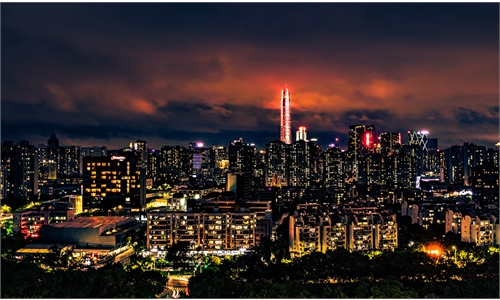Golden Week to see 650m trips, as tourism recovery continues despite challenges
Spending to near pre-pandemic levels despite challenges

Tourists view the sunrise at a scenic spot in Hezhang County, southwest China's Guizhou Province, Sept. 4, 2021. (Xinhua/Yang Wenbin)
The upcoming National Day holiday, dubbed as the Golden Week for strong tourism and consumption, is expected to see around 650 million domestic trips, surpassing the number in 2020 and reaching nearly 80 percent of the pre-COVID-19 level in 2019, with some projecting that consumption will likely reach the same level as in 2019.
The encouraging recovery trend in the domestic tourism and consumption sectors came even as sporadic outbreaks of the COVID-19 in some parts of the country continues to pose risks and as much of the world remains under serious lockdown. Analysts said that the Golden Week is expected to drive further growth of tourism and consumption, two hardest-hit areas in the Chinese economy by the epidemic.
A total of 650 million domestic trips is expected during the Golden Week starting on Friday, which marks China's National Day, according to Chinese online travel platform ly.com.
The number of trips is projected to be nearly 80 percent of that in 2019, which was 782 million. Domestic tourism revenue was at 649.71 billion yuan ($100.5 billion) in 2019, according to the Ministry of Culture and Tourism.
China Railway Guangzhou Group Co said Wednesday that the company is expected to see 19 million passenger trips from Tuesday to October 8, with a daily average of 1.73 million trips. The company mainly operates railways in Central China's Hunan Province, South China's Guangdong and Hainan Province.
"Affected by COVID-19 outbreaks in July and August, the demand for summer travel had not been released. Therefore, there is a strong desire for compensatory travel. Meanwhile, some scenic spots have introduced preferential measures to attract tourists," Hou Zhengang, an official with the Ministry of Culture and Tourism, said Wednesday during a press conference.
With the COVID-19 remain effective under control in China and the successful epidemic prevention experience during the May Day holiday and the Mid-Autumn Festival holiday, people's safety concerns about domestic travel have gradually disappeared, a Shanghai-based tourism analyst surnamed Ji told the Global Times on Wednesday, adding that this year's tourism and spending should be stronger than in 2020 and recover to near 2019 levels.
The number of people planning to travel during this National Day holiday increased by 49 percent from 2020, with trips within provinces increasing by 64 percent year-on-year, while cross-provincial trips rising by 44 percent, according to a consumption trend forecast released by Meituan on Tuesday. Regional and short-distance tours will be many peoples' first choice, according to Meituan, adding that local dishes, hot pot and hot springs are among the hottest search words online.

Tourists enter the Transformers section of the Universal Beijing Resort on Monday, one day ahead of the Mid-Autumn Festival in China. The highly-anticipated resort officially opened for business on Monday after 19 days of trial operation. Photo: cnsphoto
Boosted by the opening of the Universal Beijing Resort, which officially opened on September 20, and other factors, the number of people planning to visit Beijing increased by 173 percent compared with 2020, according to Meituan.
As the COVID-19 pandemic remains severe in many places around the world, the demand for overseas travel has been reallocated to domestic travel, Yang Delin, a senior research fellow of Tongcheng Research Institute under China's ticketing website LY.com, told the Global Times.
In 2019, before the COVID-19 pandemic, Chinese tourists made 155 million overseas trips and spent $254.6 billion on overseas travel, according to official statistics from the Ministry of Culture and Tourism and the State Administration of Foreign Exchange. A total of 6.006 billion domestic trips were made in 2019.
Yang said that the domestic industry should seize the opportunity to boost consumer demand and promote high-quality consumer spending, develop digital and smart tourism industries and rural tourism, which will accelerate the modernization of rural areas and advance rural revitalization strategy.
But since there are still some cases of COVID-19 sparking in East China's Fujian Province and Northeast China's Heilongjiang Province, authorities have asked those who will travel to closely monitor the spread of local infections and avoid choosing destinations in medium-risk and high-risk regions.
Hou reminded tourists to observe the prevention and control requirements such as health code inspection, temperature checking and masks, and wash hands and maintain social distancing where possible. Authorities also called for vaccination to keep safe.
As of Tuesday, a total of 2.2 billion COVID-19 vaccine doses were inoculated nationwide, and 1.05 billion people had completed the full course of vaccination, according to official data.



